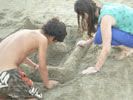Eye For Film >> Movies >> Año Uña (2007) Film Review
The camera never lies, they say. But like all conventional wisdom, it's simply not true, and Jonás (Son of Y Tu Mamá También director, Alfonso) Cuarón's unusual Year Of The Nail tramples over the phrase once again, in an interesting but ultimately unsatisfying debut.
"Concept" film is perhaps a little too loaded a term to use here, but Cuarón has attempted to make his get away from daddy in an unusual manner. Year Of The Nail's premise is that it is composed of hundreds of still photographs taken by the young director during the course of a year. These collect everything from a trip to the vets, to his grandfather undergoing chemotherapy (he sadly died shortly after). Taking these images, he melds a completely fictional story tracing the inter-secting lives of an American language student and a Mexican teenager through four seasons, all voiced by the people in the snaps.

Molly (Eireann Harper) plays herself as a backpacking undergrad keen to slum it with those poor folk down in Mexico, only to find that they're not all poor. Diego (Diego Cataño) is the pubescent son of the wealthy family who welcome her in, and who turns his attentions from his cousin to her when she reciprocates his attention, keen to master her Spanish.
Diego's character is well sketched out, from his roving eyes to his nervous mumbling, and one wonders whether his humping dog testosterone hit a little too close to home for 15-year-old Cataño. But Molly is from New York and - surprise, surprise! - she's neurotic, probably from the east village, and having a fling with a college professor. This has become such a cliche in films that I'm starting to get neurotic about it. First she worries that she's not seen the real side of Mexico, then she worries that the people she stays with are too rich, then she worries that she's embarassing herself on the beach, then she worries that Diego is coming on to her. She never stops fretting, and it never stops grating.
It's a shame really as the idea behind the film - that life's small everyday beauties fly past us in an instant, and should be savoured - is one that can never be said enough. The name of the film symbolises how life's best times are only remembered in association with the most mundane things: in this case, Diego's ingrowing toe nail. And a romance between a young woman and a feral but fawning (Diego travels all the way to New York to impress Molly) adolescent male could well have been sweet had the still images not clashed with most of the voice acting, which is not so much bad as entirely remote and detached from the images on screen. Of course it's an illusion, but the best ones don't feel like they are. As such it feels like one long trawl through the photo album of somebody else's holiday.
But the main problem is that it's not original. For one, see Chris Marker's 1962 sci-fi La Jetée for a film entirely made of stills. It's not novel in anyway: people have been taking photos of real life situations and turning them into fiction for more than a century. More impressive would have been if Cuarón had managed to take video footage of these events and turn it into a completely different story, a more demanding challenge, surely? Except that's been done before too - in, er, the Magic Roundabout of all things.
Jonás has it in him to produce a touching film, there's no doubt, but perhaps frustratingly for him, if he stopped trying so hard to avoid his father's shadow he might well get out from under it.
Reviewed on: 07 Mar 2008
















